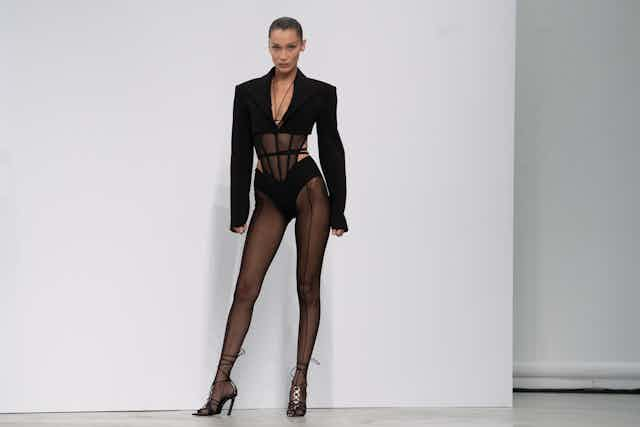Two years after legendary French designer Thierry Mugler’s death, his brand, now under creative director Casey Cadwallader, continues to be committed to its creator’s vision of “a new woman … fierce, sultry, powerful and enigmatic”.
Mugler became an icon of haute couture in the 1980s, but it was in the 21st century that he shaped mainstream imagination. He spent his last decades dressing mega-celebrities including Lady Gaga and Beyoncé, inventing, almost single-handedly, the style of our current pop divas: what he called the “glamazon” look.
Staples include corseted waists, futuristic metal plates, exaggerated breasts and shoulders, insect-like and reptilian gowns, skin-tight bodysuits and plenty of theatrical opulence. This look remains central to the Mugler brand and is likely to be reflected in designs in the upcoming Fall/Winter 2024-2025 Mugler show at Paris fashion week.
By the time Mugler passed away in 2022, headlines said he had made “feminism sexy and powerful” and called him a “visionary who let women mean business”. However, earlier in his career, Mugler was often accused of sexism and of being offensive to women.
Despite the evident change in public opinion towards his work in recent decades, the vision that garnered him criticism is still present in the Mugler brand identity and continues to be worth a closer examination.
Sex subjects or objects?
One of Mugler’s last critics was feminist scholar Sheila Jeffreys, who accused him of reducing women to “objects for men’s sexual excitement”. His designs prevented breathing, contorted the body, hypersexualized women and portrayed them as insects. For Jeffreys, this was all evidence of “extreme misogyny” and of women being treated as things to be bent to the will of the (male) creator, rather than as human beings.
But many insisted that this was a misunderstanding. Mugler was taking femininity and making it a source of power rather than of subordination. Feminist art historian Linda Nochlin said Mugler’s approach was “so extreme that these women aren’t sex objects; they’re sex subjects”. Journalist Danièle Bott saw him not as objectifying the body, but rather as “embarking on a spiritual quest in search of perfection, a celebration of the cult of the body”.“
These designs make women so sexualized that they turn from objects to subjects; so cinched that they are not objectified but celebrated.
At the recent Dune: Part Two premiere, American actor Zendaya stunned fans in a vintage futuristic robot suit from Mugler’s archives, complete with see-through buttocks and breasts. The actress was hailed as an "otherworldly”“metallic goddess, ”, not a mere sexual object.
Time and time again, Mugler’s designs manage to revive an almost religious attitude of reverence towards women that makes them feel and look powerful. But where does that power come from?
Divine things
One aspect of Thierry Mugler’s creative genius was the array of figures populating his shows: mermaids, dominatrices, vampires, Amazons, cowgirls, ancient goddesses, bird-women, insect-women and space-age robots. There was always a new, exciting heroine to delight his audience. But this variety also reflected a fundamental principle of Mugler’s vision: in all these guises, the Mugler woman is fundamentally a fantasy, unreal and shapeshifting.
This constantly morphing quality is what makes a Mugler woman an alluring mystery. This is also why it’s important that her body look impossible.
When Mugler designed an illusion water-dripping, flesh-coloured dress for Kim Kardashian’s 2019 Met Gala appearance, the result was so extreme the internet was left wondering if ribs had been removed. But the painfully corseted latex was essential. Its strangeness changed Kardashian from a flesh and bone human into a powerful “rain drop queen”.
It’s unclear that this is the kind of empowerment feminists should be after. Philosopher Simone de Beauvoir warned about this in The Second Sex: “As powerful as [a goddess] may appear, she is defined through notions created by the male consciousness.”
In George Michael’s Too Funky music video, it’s Michael in the roll of cameraman that watches those divine supermodels dominating the catwalk in Thierry Mugler’s creations. Being a fantasy is a heady experience, but it requires an onlooker, a worshipper. And worship is a tricky thing because the power it confers is precarious and unstable.
Fashion critic Marylou Luther noticed that Mugler sent “super-supermodel Pat Cleveland to fashion heaven as the Virgin Mary one season, (…) banishing her to hell as the bride of Lucifer the next”. In her eyes, this was just one of his “playful irreverences”. But this oscillation is emblematic of the core logic of “woman as fantasy”. To keep being a mystery, a stimulating riddle, she must be ethereal goddess one moment, diabolical vamp the next.
We should be wary here. Being a fantasy is a double-edged sword and contains within it the seeds of both worship and profound hatred. Mugler’s cult of woman as a transcendental goddess is dangerous because it can quickly turn into demonising women and seeing them as the embodiment of evil. In fact, it requires that turn. Eventually even the most sparkling angel becomes boring and predictable.

Looking for something good? Cut through the noise with a carefully curated selection of the latest releases, live events and exhibitions, straight to your inbox every fortnight, on Fridays. Sign up here.

